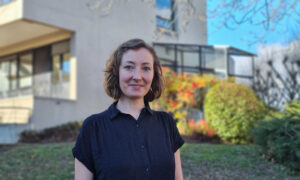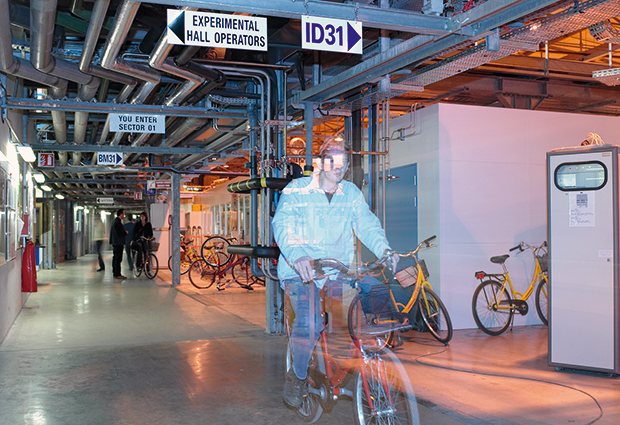
Read the latest Issue


Now: Retired, Palmerston North, New Zealand
At EMBL Heidelberg: 1976–1981 Group Leader
At EMBL Grenoble: 1981–1998 Group Leader and Senior Scientist
What brought me to EMBL? Well, EMBL was brought to me since I was already in Heidelberg at the Max Planck Institute for Medical Research. The choice of EMBL building had just been made, and I was asked by Sir John Kendrew, EMBL’s Director General, to design the layout of the labs based on my experience in redesigning the MPI labs. I also designed the P4 facility required for genetic manipulation.
When my contract was coming to an end, I applied to EMBL for a position that allowed me to continue with my group at the MPI and our studies on polypeptide elongation factor Tu (EF-Tu). This was going well and we had crystals. My application was successful, and I was appointed group leader in 1976, publishing the first study of protein crystals with synchrotron radiation at EMBL Hamburg with Arnold Hamsen and Georg Schulz.
I retired in 1998 with a certain amount of satisfaction in my role in building and establishing an EMBL Outstation in Grenoble.
To make neutron diffraction measurements for our studies, we visited EMBL Grenoble at the Institut Laue-Langevin (ILL). Here I met Bernard Jacrot, the future head of the Outstation, who offered me a post at Grenoble for my neutron diffraction studies and to organise the biochemical labs. I, and my assistant Bruno Antonsson moved to Grenoble in 1981. With my modifications for safety and the superb support of Jean-Marie Bois (electrics), Joe Sedita (workshop) and Annie Simon (stores and kitchen) the Grenoble building was eventually completed.
Subsequently, with Marie-Thérese Dauvergne a deuteration facility was established and Michael Härtlein introduced DNA manipulation. I led an extensive research programme into seryl- and asparaginyl-tRNA synthetases and organised the first international workshop on aminoacyl-tRNA synthetases in 1991. Our work led to breakthroughs such as understanding the relationship between the GTP-binding domain of EF-Tu and p21 and we collaborated with Outstation crystallographers to solve important crystal structures such as seryl-tRNA synthetase and the first G-protein-exchange factor complex (EF-Tu/EF-Ts).
Moving is not easy for family. My wife, Pat, established a social life with a small group of expat wives, organising meetings at the group’s houses open to all; she called this “Open House”. This became so popular that “Open House” still exists 30 years on with 150 members! I retired in 1998 with a certain amount of satisfaction in my role in building and establishing an EMBL Outstation in Grenoble.

Now: Governor’s Chair at the University of Tennessee and founding Director of the Oak Ridge National Laboratory (ORNL) Center for Molecular Biophysics, USA.
At EMBL Grenoble: 1982–1985, PhD student, Cusack group
I arrived at EMBL Grenoble in August 1982 a day late, having dreamily got on the wrong ferry when travelling from London, thus arriving in France with only my passport and two pounds on me. After a night sleeping rough, some careful negotiations and a spot of hitchhiking, I somehow got back on track to be greeted by the then Head of Outstation Bernard Jacrot proclaiming: “Your reputation as an absent minded scientist is already firmly established!” It was the beginning of an adventure in life and science.
Led by my curiosity about neutrons and a desire to learn a foreign language, I set about performing calculations, simulations and scattering experiments as the first student in the lab of a young Stephen Cusack, who is now the Outstation Head. There were catastrophes, arguments about theory and much hard work, but a new field was established and we had a fantastic collaboration with protein dynamics pioneer and future Nobel Laureate Martin Karplus, who I went on to work with as a postdoc.
Your reputation as an absent minded scientist is already firmly established!
Stephen’s interests shifted from physics to crystallography, and he moved briefly to Harvard to study while I remained in Grenoble playing rock music in a local bar and finishing my PhD! I remember being somewhat peeved that such a brilliant physicist as Stephen would be lost from the physical side of things, moving into what I then considered the relatively ‘easy’ field of crystallography. I know better now, of course, maybe.
After my postdoc I set up a group in Saclay, France, before becoming Germany’s first Chair in Computational Biology, at the University of Heidelberg, and then moved to my current role at ORNL in 2006. There are some fantastic toys to play with here – including the world’s most powerful neutron source and second most powerful supercomputer. Protein structures are beautiful, but to me unveiling the energies and conformational fluctuations needed to understand function will always remain more interesting than ‘stamp-collecting’ structures (I am evilly grinning right now!) – although many crystallographers, including Stephen, will disagree!

Now: Group leader, Department of Biochemistry, University of Oxford
At EMBL Grenoble: 2003–2006, PhD student, Cusack group
When I arrived in Grenoble in Summer 2003, the town was engulfed in a massive heat wave, known as the ‘canicule’. Neron, a big mountain close to the EMBL Outstation, had been struck by lightning and was on fire, filling Grenoble with smoke and ash and most sensible people had fled to higher altitudes. Fortunately things quickly got better: the lab was air-conditioned, I had an exciting project, and everyone seemed to
love science – I immediately felt at home!
Some of my best scientific memories come from the ESRF synchrotron, where we collected diffraction data from crystals: the sophisticated electronic equipment gives the feel of being onboard a spaceship. Meanwhile, my supervisor Stephen Cusack was like the Captain Picard of crystallography, instinctively knowing how to get the best data from a crystal – sometimes even correctly guessing the 3D arrangement of molecules inside. Group leader Andrew McCarthy, who I still collaborate with, was another hero of my synchrotron time: he put together much of the beamline hardware, and his work in neural guidance factors inspired me to go into this field in my postdoc and beyond.
The sophisticated electronic equipment gives the feel of being onboard a spaceship.
My projects also involved collaboration with teams outside EMBL – for example the lab of Eric Kremer in Montpellier, where I worked closely with a wonderful postdoc, Harald Wodrich. Looking back, I realise how incredibly lucky I am to have worked at EMBL Grenoble. Not only is Stephen a perfect supervisor, but working in his lab kindled my passion for science and led me to pursue a career in academic research.

Now: Director, Institut de Biologie Structurale (IBS), Grenoble
At EMBL Grenoble: 1998–2006, Group leader
After a postdoc at Harvard, I wanted to return to Europe and spotted a rare opportunity to become a group leader at EMBL Grenoble. Immediately, I was submersed in a fantastic environment for setting up a research group, and this atmosphere remains to this day. EMBL provides sufficient funding to establish teams, pursue projects, and publish independently, building and enhancing the international reputation of researchers in the process.
Using a range of molecular biology, protein chemistry, X-ray crystallography and electron microscopy approaches, our group at EMBL Grenoble made important contributions in the field of structural virology. One notable example is our work on Ebola virus assembly and the conformational flexibility of its matrix protein. We also carried out work revealing the molecular details of how RNA nucleoproteins polymerise with their genome into nucleocapsids and published the first crystal structure of an ESCRT–III budding factor.
Since leaving EMBL, our research focuses on HIV-1 entry and cellular budding factors that are recruited by enveloped viruses such as HIV-1 to complete budding. One of the most exciting aspects is just how much more there is still to learn – we ultimately want to understand how HIV-1 entry can be blocked by vaccine induced antibodies and how enveloped viruses get out of cells.
One of the most exciting aspects is just how much there is still to learn.
We maintain close connections with EMBL Grenoble through the Partnership for Structural Biology (PSB). EMBL is special due to our common mission of performing excellent basic science. Our vision for the future is closer links through the extension of existing bilateral infrastructure projects on electron microscopy and scientific projects by fostering scientific collaborations.
Looking for past print editions of EMBLetc.? Browse our archive, going back 20 years.
EMBLetc. archive